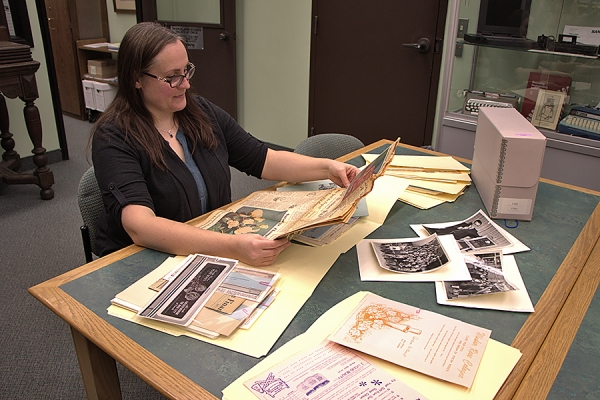What's in a name? That which we call Rose City by any other name would still be Windsor.
While Shakespeare's Juliet argues that names are irrelevant, the intention behind Windsor's moniker was quite the opposite.
In the early 1960s, Windsor had what Leddy Library archivist Sarah Glassford described as an image issue. The city's economy had risen and fallen alongside the auto industry, and the memory of past labour disputes remained. Those outside the city viewed Windsor as a "gritty, blue-collar town" and a tough place for business to thrive.

Archivist Sarah Glassford reviews documents detailing Windsor's history as the Rose City
"People from here didn't think that was a very accurate representation of what Windsor was really like, and they wanted to change its reputation," Glassford explains.
A group of civic leaders businessmen, politicians, and educators formed the Greater Windsor Foundation and crafted a "rebrand" inspired by the city's rose-friendly climate and conditions. The group encouraged rose planting at Jackson Park and City Hall and launched marketing campaigns in a bid to help Windsor bloom into the "Rose City."
Chair of the foundation's Rose Committee, Doug Johnstone, decided to take the campaign a step further. As the sales promotion manager at the Windsor headquarters of Beauty Counselors of Canada a direct-sales cosmetics company similar to Avon or Mary Kay he integrated the campaign into the business, launching a Windsor Rose product line, with the rose becoming a theme for many company activities.
"There was Windsor Rose lipstick, Windsor Rose blush, and Windsor Rose teacups and all sorts of things," says Glassford. "They brought the winner of the Miss Canada pageant to Windsor to do some publicity around this when they had a convention here and just sort of tied it into their business."
She notes that it was the women sales representatives and customers who played a large role in helping the campaign take root.
"They would go door to door, selling this idea of Windsor and roses to women in their homes, through cosmetics sales with the result that women ended up sort of wearing this branding on their bodies," Glassford says.
Johnstone donated materials about the campaign to the Leddy Library Archives and Special Collections old photographs, ticket stubs, sales brochures, and internal company newsletters promoting the Windsor Rose product line along with news clippings that had originally been part of a scrapbook.
"The newsletters are interesting because they offer insight into both the rebranding effort and the role of women in the campaign, showing how the sales representatives were encouraged to promote this product line.
"The collection foregrounds the rebranding campaign for Windsor, but at the same time, it also contains a lot of information about women's employment opportunities and beauty culture at the time," notes Glassford.
Though traces of the rose campaign have been left behind in the archives, its connection to the city's identity has faded over time.
Glassford points out that part of the reason Rose City may not have an obvious tie to present-day Windsor a city better known for its automotive ties than its rose beds may be a 2009 pesticide ban that led to a substantial reduction of the flower in parks around the city.
More than 60 years later, the city may no longer be defined by its roses, but the "Rose City" nickname has endured.










